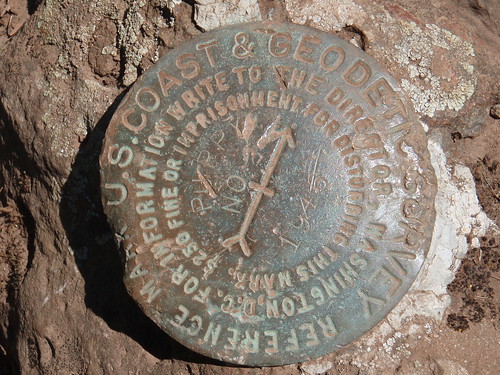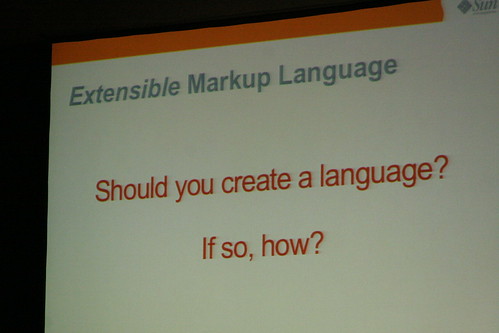Posted May 18th, 2009 by
rybolov
So I was doing my usual “Beltway Bandit Perusal of Opportunities for Filthy Lucre” also known as diving into FedBizOps and I found this gem. Basically what this means is that sometime this summer, NIST is going to put out an RFP for contractors to further develop SCAP using ARRA funds.
Keeping in mind that this isn’t the official list of what NIST wants done under this contract, but it’s interesting to look at from an angle of where SCAP will go over the next couple of years:
- Evolution of the SCAP protocol and specifications thereof
- Feasibility studies, development, documenting, prototyping, and road-mapping of SCAP expansions (e.g., remediation capability) and analog protocols (e.g., Network Event Content Automation Protocol
- Implementation and maintenance support for the Security Automation Content Validation Program
- Maintenance support for the SCAP Product Validation Program
- Pilot, beta, and production support for SCAP and security automation use-cases
- Content development, modification, and testing
- Infrastructure and reference implementation development in JAVA, C++, and C programming languages
- Data trust models and data provenance solutions.
So how do you play? Well, the first thing is that you respond to the notice with a capabilities statement saying “yes, we have experience in doing what you want”–there is a list of specifics in the original notice. Then sign up for FedBizOps and follow the announcement so you can get changes and the RFP when it comes out.
Similar Posts:
Posted in NIST, Outsourcing |  5 Comments »
5 Comments »
Tags: 800-53 • fisma • infosec • infosharing • management • metrics • moneymoneymoney • NIST • scalability • scap • security
Posted May 7th, 2009 by
rybolov
Check out this blog post. Wow, all sorts of crazies decend out of the woodwork when Bruce talks about something that’s been around for years and suddenly everyone’s redesigning the desktop from the ground up.
Quick recap on comments:
- 60-day password changes suck
- You can do this at home, the GPOs are available from NIST
- My blue-haired sheepdog can’t use the FDCC image, it’s broken for commercial use!
- You wouldn’t have to do this in Linux
- Linux is teh suxx0rz
- My computer started beeping and smoke came out of it, is this FDCC?
Proving once again that you can’t talk about Windows desktop security without it evolving into a flamewar. Might as well pull out “vi v/s emacs” while you’re at it, Bruce. =)

Computer Setup photo by karindalziel. Yes, one of them is a linux box, I used this picture for that very same reason. =)
But there is one point that people need to understand. The magic of FDCC is not in the fact that the Government used its IT-buying muscle to get Microsoft to cooperate. Oh no, that’s to be expected–the guys at MS are used to working with a lot of people now on requests.
The true magic of FDCC is getting the application vendors to play along. To wit:
- The FDCC GPOs are freely available from NIST
- You can download images from NIST with a preconfigured FDCC setup
- Application vendors can test their product against FDCC in their own lab
- There is no external audit burden (yet, it might be coming) for software vendors because it’s a self-certification
- FDCC-compatible software doesn’t require administrative privileges
In other words, if your software works with FDCC, it’s probably built to run on a security-correct operating system in the first place. This is a good thing, and in this case the Government is using its IT budget to bring the application vendors into some sort of minimal security to the rest of the world.
This statement is from the FDCC FAQ, comments in parenthesis are mine:
“How are vendors required to prove FDCC compliance?
There is no formal compliance process; vendors of information technology products must self-assert FDCC compliance. They are expected to ensure that their products function correctly with computers configured with the FDCC settings. The product installation process must make no changes to the FDCC settings. Applications must work with users who do not have administrative privileges, the only acceptable exception being information technology management tools. Vendors must test their products on systems configured with the FDCC settings, they must use SCAP validated tools with FDCC Scanner capability to certify their products operate correctly with FDCC configurations and do not alter FDCC settings. The OMB provided suggested language in this memo: http://www.whitehouse.gov/omb/memoranda/fy2007/m07-18.pdf, vendors are likely to encounter similar language when negotiating with agencies.”
So really what you get out of self-certification is something like this:
Similar Posts:
Posted in Technical |  4 Comments »
4 Comments »
Tags: cashcows • certification • compatibility • compliance • fdcc • government • infosec • moneymoneymoney • NIST • omb • scalability • scap • security
Posted April 10th, 2009 by
rybolov
Some of my friends (and maybe myself) will be teaching the NIST Framework for FISMA in May and June with Potomac Forum. This really is an awesome program. Some highlights:
- Attendance is limited to Government employees only so that you can talk openly with your peers.
- Be part of a cohort that trains together over the course of a month.
- The course is 5 Fridays so that you can learn something then take it back to work the next week.
- We have a Government speaker ever week, from the NIST FISMA guys to agency CISOs and CIOs.
- No pitching, no marketing, no product placement (OK, maybe we’ll go through DoJ’s CSAM but only as an example of what kinds of tools are out there) , no BS.
See you all there!
Similar Posts:
Posted in NIST, Speaking |  1 Comment »
1 Comment »
Tags: 800-30 • 800-37 • 800-53 • 800-53A • 800-60 • accreditation • C&A • catalogofcontrols • categorization • certification • compliance • fdcc • fips-199 • fips-200 • fisma • gettingtogreen • government • infosec • infosharing • NIST • privacy • publicpolicy • risk • S3474 • scap • security • securitylob • seminar • speaking • tools • training
Posted March 19th, 2009 by
rybolov
So way back in the halcyon days of 2008 when Dan Philpott, Chris Burton, Ian Charters, and I went to the NIST SCAP Conference. Just by a strange coincidence, Ed Bellis threw out a twit along the lines of “wow, I wish there was a way to import and export all this vulnerability data” and I replied back with “Um, you mean like SCAP?
Fast forward 6 months. Ed Bellis has been busy. He delivered this presentation at SnowFROC 2009 in Denver:
So some ideas I have about what Ed is doing:
#1 This vulnerability correllation and automation should be part of vulnerability assessment (VA) products. In fact, most VA products include some kind of ticketing and workflow nowadays if you get the “enterprise edition”. That’s nice, but…
#2 The VA industry is a broken market with compatibility in workflow. Everybody wants to sell you *their* product to be the authoritative manager. That’s cool and all, but what I really need is the connectors to your competitor’s products so that I can have one database of vulnerabilities, one set of charts to show my auditors, and one trouble ticket system. SCAP helps here but only for static, bulk data transfers–that gets ugly really quickly.
#3 Ed’s correllation and automation software is a perfect community project because it’s a conflict of interest for any VA vendor to write it themselves. And to be honest, I wouldn’t be surprised if there aren’t a dozen skunkwork projects that people will admit to creating just in the comments section of this post. I remember 5 years ago trying to hack together some perl to take the output from the DISA SRR Scripts and aggregate them into a .csv.
#4 The web application security world needs to adopt SCAP. So far it’s just been the OS and shrinkwrapped application vendors and the whole race to detection and patching. Now the interesting part to me is that the market is all around tying vulnerabilities to specific versions of software and a patch, where when you get to the web application world, it’s more along the lines of one-off misconfigurations and coding errors. It takes a little bit of a mindshift in the vulnerability world, but that’s OK in my book.
#5 This solution is exactly what the Government needs and is exactly why SCAP was created. Imagine you’re the Federal Government with 3.5 million desktops, the only way you can manage all those is through VA automation and a tool that aggregates information from various VA products across multiple zones of trust, environments, and even organizations.
#6 Help Ed out! We need this.
Similar Posts:
Posted in Technical, What Works |  4 Comments »
4 Comments »
Tags: datacentric • genius • government • infosec • infosharing • management • metrics • scalability • scap • security • tools
Posted October 2nd, 2008 by
ian99
There is another challenge that SCAP addresses without it being officially on the SCAP program’s agenda. With the advent of SCAP we now have a common reporting criteria by which we can now judge SCAP certified products. If you have ever used an automated vulnerability scanner as part of a penetration test or security audit, you know that not all vulnerability scanners are created equal. Some have much lower false positive alert and reporting rates than others. Likewise, it is known that false negative alert and reporting rates vary. And, because of the various technical approaches taken by the scanners, some provide much more consistent results. The challenge has been that without a common criteria to test against, it is difficult for a small or even fairly large security organization to find the resources to effectively test these products in a fair apples to apples test.
This is where NIST has a real opportunity on its hands. With the release of the SCAP protocol, we have the criteria by which performance comparisons can be made. What we are lacking is a common test environment.

Benchmark photo by bzo.
Let me veer off-topic for a moment to provide some background. In the last few years the Linux community has created various “live distributions” for various specialized requirements. What live distributions are, are CD, DVD or Flash-media-based operating systems that are executed upon boot. That is to say that they boot and run directly from CD or DVD. So, by using a Linux live distribution, you can run Linux off of you home Windows-based laptop without ever installing Linux to your hard disk. This has opened up a world of specialized possibilities for this community. One of them is the standardized training environment. For example, security testers have created DVL (damn vulnerable Linux http://www.damnvulnerablelinux.org/). DVL is a live distribution that with well documented security vulnerabilities, this distribution is used as a training aid for teaching vulnerability assessment and mitigation. There are other similar efforts created with the same intent such as the excellent DE-ICE training targets (http://de-ice.net/hackerpedia/index.php/De-ICE.net_PenTest_Disks).
NIST could follow-up on the release of the SCAP protocol by also building and releasing a common testing environment based perhaps on live distribution technology. Such an environment with well documented vulnerabilities would allow for the creation of objective benchmarks to be created to rate the accuracy, reproducibility, completeness of the results of SCAP certified vulnerability testing and reporting products. This would aid government agencies, businesses and even individuals in their purchasing decisions. It would also allow provide vendors with an objective and common test environment in which they can test and improve their products. I admit this would be a significant undertaking for NIST. However, I would suggest that such a test environment could be designed in such a manner that it could be built and released as a series of inter-operable modules based on live distribution technology. The initial release might only offer a relatively modest set of tests but with the release of each module building on the results of previous releases, a highly demanding and sophisticated test environment could soon be realized. Because of the importance and utility of such a project, industry and outside security experts might want to participate in and contribute to such an endeavor.
Similar Posts:
Posted in NIST, Technical, What Works |  No Comments »
No Comments »
Tags: certification • government • infosec • infosharing • management • pwnage • risk • scap • security
Posted October 1st, 2008 by
ian99
I was attending a conference at NIST (the National Institute of Standards) concerning the SCAP program (Security Content Automation Protocol; pronounced ESS-cap). SCAP is focused on providing the Federal government with automated, common, interoperable security solutions. Specifically the SCAP program has developed a common set of standards for reporting security vulnerabilities for use in automated security scanners, security appliances and reporting systems.
Well, why do we need SCAP? If we use the Godfather of all vulnerability management tools, the NESSUS vulnerability scanner as an example, we have seen that industry has produced a number of similar products. Each has its own strengths and rich feature set. However, none of them use the same “language” for detecting or describing or reporting a potential vulnerability. This not only means that these various products can only be used to operate with each other with some measure of difficulty but, trying to aggregate and manage the result of reports from these systems can be tedious.

“Tim Bray at XML 2005” photo by Roland.
As a result of these efforts and vision of the dedicated employees at NIST, industry is already scrambling to get their related products SCAP certified. And, Federal agencies are also specifying in contracts that products must be SCAP certified in order to be qualified for purchase. This is real progress and great news for the tax payer who will get real better value for their tax dollar. But, it is not a revolution — yet. Where I see the revolution emerging is in six-month to a year time frame when industry takes note of the SCAP program and we begin to see SCAP certified and SCAP interoperable products being ordered. It will not be long after that that we may see the SCAP protocol used in even consumer-level products like personal firewalls. This ability to give us all a common language will significantly reduce the cost of building and supporting vulnerability scanners and vulnerability reporting tools. This cost reduction will allow resources to be freed up to address prevention and mitigation concerns in a more meaningful manner.
For example, industry has tools that enable network and security support professionals to detect a mis-configuration in a desktop machine in their network and correct it. But, only the largest and most well funded security IT security departments have such tools. With the advent of SCAP, these kind of services will be much more affordable and supportable and thus more common. In fact, because much of this can be automated, I can even envision the McAfee, Symantec, and others who are well placed in the vulnerability scanning market to offer support services over the wire to smaller businesses and to consumers. Moreover, as this technology improves and becomes commoditized, I can see ISP’s offering security scanning and mediation as a service to their customers.
Similar Posts:
Posted in NIST, Technical, The Guerilla CISO, What Works |  No Comments »
No Comments »
Tags: certification • compatibility • government • infosec • management • scap • security • tools
 5 Comments »
5 Comments » Posts RSS
Posts RSS



